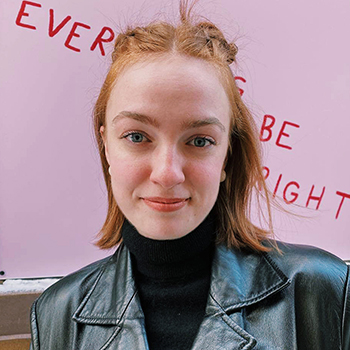Search for academic programs, residence, tours and events and more.

At Wilfrid Laurier University’s 2021 Academic, Creative and Engaged Research Showcase (ACERS), virtual attendees were treated to a multidisciplinary array of undergraduate student research. The five researchers who won the top prizes tackled topics as diverse as psychological horror in video games, cancer treatment, sex offender rehabilitation, personal identity and the first Black opera.
Since this year’s ACERS competition was held online, students were invited to submit their work in one of three formats: poster, video or podcast. See and listen to award-winning research by:

Travelling Home
First place in Podcasts category
At the beginning of her podcast, Travelling Home, Gabriela Latta Suazo says: “For a long time, I felt I was only ever a third of the way home.” Though Latta Suazo has spent the majority of her life living in Kitchener-Waterloo, her mother and father’s extended families live in Chile and British Columbia respectively, places she visited often during her childhood. As a person of mixed race who can speak fluent Spanish, yet is often perceived to be Caucasian, these fragmented connections to “home” further complicate Latta Suazo’s search for her identity.
Travelling Home explores the making of her short film, Three Homes, which Latta Suazo produced for an assignment in one of her North American Studies courses at Laurier. A fourth-year student in the Community Music program, Latta Suazo used footage she filmed on family trips to British Columbia and Chile in high school to show her homes “through car windows, curtains, walks and memories.”
Way back in Grade 11, why did you decide to film your three homes?
GLS: “I just got this feeling that I needed to document these three places. I realized that my grandparents were getting older and I was getting older and I wouldn’t be able to go on family trips to these places as often. I needed to preserve them somehow, so I filmed everything. The footage captures the knickknacks, the fixtures, the environments and landscapes outside that brought me comfort and made me feel home.”
What did you learn about yourself and your identity through the filmmaking and podcasting processes?
GLS: “This project helped me accept the fact that I have these three distinct places that I call home, and it's okay that it's complicated. My work connected me with others who told me, ‘This is exactly how I feel.’ It is up to each of us to determine where we feel at home, and it doesn't even have to be a physical location. It can be with a person or a group of friends. It is easy to feel like if you haven't lived somewhere for 20 years or you don’t know how to get around the city, then it can’t be home. I don't really know the streets of Chile, but I know my grandparents’ house and to me, that is home.”
How does storytelling and filmmaking align with our traditional ideas of research?
GLS: “I have learned throughout my degree that reflection and personal discovery are valid forms of research. You are learning something about yourself and by doing so, it can help other people. Other people can connect with your stories and experiences or come to understand different perspectives in a way that they can’t by reading a quantitative study. So while traditional research is very important, I think that accepting reflection as research is equally important.”
Psychological Horror in Video Games
First place in Videos category (tie)
James Gautrey conducted his award-winning research at his home in Birmingham, England. Gautrey, an English and Theatre major at the University of Birmingham, is attending Laurier as an exchange student. A lifelong video game fan, Gautrey was excited to take Laurier’s Gaming and Narrative Theory course and turn a psychoanalytic lens onto his favourite genre: horror.
In the video presentation of his research, Gautrey analyzes six video games and the ways they draw upon literary theories and concepts such as Sigmund Freud’s theory of the uncanny to create immersive horror experiences.
How did it occur to you to view video games through the lenses of psychoanalysis and literary theory?
JG: “I can't turn off my literature and theatre-analysis brain. My dad is always getting annoyed at me when we're watching TV and I say, ‘But do you see the camera work?’ It's the same when I’m playing video games. For example, I was playing a game called Persona 5, which explores a lot of psychological concepts, and then I started making connections to other games. The more I made those connections, the more I connected psychological theories to the horror genre in general. In any book or show or video game, there are always deeper levels at play and I feel like it's really important to unpack them, especially in popular media, because this is the media that everybody is consuming. It's what we are all being influenced by unknowingly.”
In the video, you speak about how video games lend themselves well to the horror genre because they are “immersive narratives.” Can you explain that?
JG: “When you're playing a video game, you can make so many choices as to how you interact with it. The game developers have placed everything right there in front of you, like a box of Lego, and you’ve got to decide how to put it together. Players can get really invested because everyone plays a game differently and it feels very personal. Freud’s definition of uncanny – things that are close to being recognizable but frightening because they are not – applies to this medium because you may find something creepy and unsettling in the game that other players don't. These games are frightening because they are so immersive and people are scared to play them by themselves.”
What can video game developers learn from your research?
JG: “I am personally trying to develop a game at the moment, so I am drawing on my own findings. My research shows game developers that they can push the boundaries of what the medium is capable of and try to craft stories that engage with theory. Being a theatre student, I see how video games can work as a performance medium. Games bring up certain feelings in you and by researching them, you can really get into the depths of why.”


Effect of Sialic Acid on Cancer Cells
People's Choice Award
Having already completed four years of study at a pharmacy school in Syria, Yara Khalaf brought a potent combination of knowledge and passion to her latest research project at Laurier. She investigated the properties of sialic acid, its effect on cancer cells and a novel, non-invasive treatment that may help prevent tumour progression.
Khalaf’s research poster, which she completed for the Chemical Literature and Scientific Communication course, was voted the people’s favourite at ACERS. It was an exciting achievement to cap off Khalaf’s tenure at Laurier as she prepares to graduate with her Bachelor of Science in Biochemistry and Biotechnology.
Why did you choose this topic for your research?
YK: “I am really interested in finding non-invasive ways to locate cancer and deliver drugs to get rid of it. I studied pharmacy for four years back home and part of my research was about breast cancer. I want to continue that. That’s why I’m pursuing master’s opportunities related to cancer studies and why I love research courses at Laurier. You get to learn in-depth about something that you’re really interested in.”
What did you learn about sialic acid?
YK: “Sialic acid is a sugar that lives on our cells. Research has found that when there is a lot of sialic acid on our cells, it can mesmerize the immune system and prevent it from noticing cancer. The immune system can’t tell if it is a good or a bad cell, so the cancer is able to grow and grow. It enhances tumour progression. Researchers have discovered a drug that can remove sialic acid from the surface of the cancer cell and allow the immune system to fight it.”
Do you feel hopeful about the future of cancer treatment after learning about this new approach?
YK: “Yes, definitely. I am amazed that they actually found a less invasive cancer treatment. Chemotherapy is harsh on our cells because it doesn't only target the bad cells, but also the good ones. There is hope that some day we will find a true solution and it will be less painful for people.”
Improving Adult Sex Offender Rehabilitation with Strength-Based Approaches
First place in Posters category
When Jennifer Kirshenbaum began applying to graduate programs in the field of forensic psychology, she realized that she could benefit from some more research experience. Kirshenbaum registered for a directed studies course, an opportunity to conduct an independent research project under the supervision of a Laurier professor. She chose to complete a literature review about rehabilitation models for convicted sex offenders.
Kirshenbaum, who will be graduating from Laurier’s Brantford campus with a combined honours degree in Criminology and Psychology, explored how and why strength-based approaches to rehabilitation reduce recidivism rates – the likelihood to reoffend – in comparison to traditional models of sex offender rehabilitation.
What interests you about the sex offender population?
JK: “The sex offender population is similar in so many ways to the general offender population, but it has unique differences that affect how we view, treat and work with them. Sex offenders’ crimes are considered the worst of the worst, yet most sex offenders don't reoffend. They have a 10 to 15 per cent chance of reoffending, which sounds like a lot, but it's actually miniscule in comparison to the general offender population. So the way that we think about them needs to change because the way that we address them is affecting recidivism rates. When you internalize expectations, there's only so much influence that other people can have.”
Describe the merits of strength-based rehabilitation.
JK: “Strength-based approaches (SBAs) are a response to traditional rehabilitation models, which are the risk-need-responsivity model and cognitive behavioral therapy. Research is very clear: both of these models work very well and they do reduce recidivism. However, many experts believe that we should be promoting strengths in addition to risk management. The traditional models are really good at managing risk, but SBAs will do so in the context of offender empowerment and engagement, helping them become a better person in general.”
Why is it important to bring a more positive, human approach to rehabilitation?
JK: “The basis of SBA is that we need to think of sex offenders as equal humans who deserve our respect. I'm not saying that we should be sympathetic or that their crimes are okay. They're definitely not. But they are no less human. One SBA is called the Good Lives Model, which assumes that we all have primary human good or goals that we want to achieve. Sex offenders are going about achieving those goals in an illegal manner, so we have to teach them how to do so without committing a crime. One way to do that is to give them autonomy over their treatment and teach them transferable skills to be successful and not reoffend once they are back in the real world.”


How Joplin's Treemonisha Challenged Societal and Operatic Norms for Black Culture
First place in Videos category (tie)
In 1911, ragtime composer Scott Joplin wrote Treemonisha, an opera about a young Black woman on a former slave plantation who is kidnapped by a conjurer. Though it was never performed during his lifetime, Joplin went on to win a posthumous Pulitzer Prize for music when it was finally staged in the 1970s.
Third-year Music Education student Maggie Van Der Sluis was intrigued to learn about the history of Treemonisha, considered to be the first all-African American opera. She says it is an outlier in the “sexist history of opera” in which “it is rare to see our heroines succeed through anything but their feminine wile or a man’s assistance.”
You like to examine opera through the lens of feminism. What makes Treemonisha a feminist story?
MVDS: “Treemonisha was written by a Black composer about a Black woman, which had never happened before. And not only is the heroine Black, but she is also very strong. Normally opera heroines are weak or frail or will do anything to please a man, but there is no love story or tragedy in Treemonisha. Treemonisha doesn't have any children, she doesn't get married. She's just a single, independent, educated Black woman who is chosen by her community to be their teacher and leader.”
In your video, you explain that Joplin wrote Treemonisha during a period when intellectual Black men were discussing the concept of “racial uplift.” How does that relate to the plot?
MVDS: “Racial uplift is an ideology that sought to better the lives of African Americans through education, self-help and moral progress. You can see it demonstrated by Treemonisha in the way she helps her community get past the nervousness they feel toward Zodzetrick, a conjurer who is attempting to sow superstition among them, through education. Given the political situation at the time and the racism that existed toward Black people, I think Joplin was voicing his opinion about those issues. It was written so long ago and it’s just as relevant today.”
What lessons can other composers learn from Joplin’s example?
MVDS: “I think they can learn to take risks and to put their opinions forward. It may cause a bit of a ruckus, but maybe years from now, another music student like me will research their work and all of its hidden meanings and important lessons. Since Treemonisha was written, there have been other operas that aren’t quite so Eurocentric and white. I even learned this past semester about two Indigenous operas, Pimooteewin and Giiwedin. People are taking their power back and writing their own stories instead of letting white people write them.”